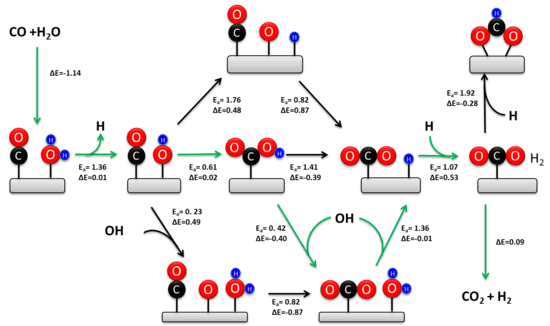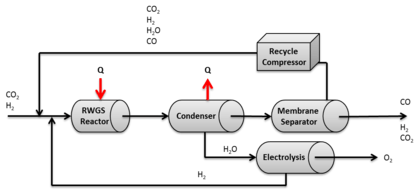Water-gas shift reaction
The water-gas shift reaction (WGSR) describes the reaction of carbon monoxide and water vapor to form carbon dioxide and hydrogen (the mixture of carbon monoxide and hydrogen is known as water gas):
- CO + H2O ⇌ CO2 + H2
The water gas shift reaction was discovered by Italian physicist Felice Fontana in 1780. It was not until much later that the industrial value of this reaction was realized. Before the early 20th century, hydrogen was obtained by reacting steam under high pressure with iron to produce iron, iron oxide and hydrogen. With the development of industrial processes that required hydrogen, such as the Haber–Bosch ammonia synthesis, a less expensive and more efficient method of hydrogen production was needed.[1] As a resolution to this problem, the WGSR was combined with the gasification of coal to produce a pure hydrogen product. As the idea of hydrogen economy gains popularity, the focus on hydrogen as a replacement fuel source for hydrocarbons is increasing.
Applications
The WGSR is an important industrial reaction that is used in the manufacture of ammonia, hydrocarbons, methanol, and hydrogen. It is also often used in conjunction with steam reforming of methane and other hydrocarbons. In the Fischer–Tropsch process, the WGSR is one of the most important reactions used to balance the H2/CO ratio. It provides a source of hydrogen at the expense of carbon monoxide, which is important for the production of high purity hydrogen for use in ammonia synthesis.
The water-gas shift reaction may be an undesired side reaction in processes involving water and carbon monoxide, e.g. the rhodium-based Monsanto process. The iridium-based Cativa process uses less water, which suppresses this reaction.
The equilibrium of this reaction shows a significant temperature dependence and the equilibrium constant decreases with an increase in temperature, that is, higher carbon monoxide conversion is observed at lower temperatures. In order to take advantage of both the thermodynamics and kinetics of the reaction, the industrial scale water gas shift reaction is conducted in multiple adiabatic stages consisting of a high temperature shift (HTS) followed by a low temperature shift (LTS) with intersystem cooling.[2] The initial HTS takes advantage of the high reaction rates, but is thermodynamically limited, which results in incomplete conversion of carbon monoxide and a 2-4% carbon monoxide exit composition. To shift the equilibrium toward hydrogen production, a subsequent low temperature shift reactor is employed to produce a carbon monoxide exit composition of less than 1%. The transition from the HTS to the LTS reactors necessitates intersystem cooling. Due to the different reaction conditions, different catalysts must be employed at each stage to ensure optimal activity. The commercial HTS catalyst is the iron oxide–chromium oxide catalyst and the LTS catalyst is a copper-based catalyst. The order proceeds from high to low temperature due to the susceptibility of the copper catalyst to poisoning by sulfur that may remain after the steam reformation process.[3] This necessitates the removal of the sulfur compounds prior to the LTS reactor by a guard bed in order to protect the copper catalyst. Conversely, the iron used in the HTS reaction is generally more robust and resistant toward poisoning by sulfur compounds. While both the HTS and LTS catalysts are commercially available, their specific composition varies based on vendor. An important limitation for the HTS is the H2O/CO ratio where low ratios may lead to side reactions such as the formation of metallic iron, methanation, carbon deposition, and Fischer–Tropsch reaction.
Low temperature shift (LTS)
The typical composition of commercial LTS catalyst has been reported as 32-33% CuO, 34-53% ZnO, 15-33% Al2O3.[3] The active catalytic species is CuO. The function of ZnO is to provide structural support as well as prevent the poisoning of copper by sulfur. The Al2O3 prevents dispersion and pellet shrinkage. The LTS shift reactor operates at a range of 200 oC to 250 oC. Low reaction temperatures must be maintained due to the susceptibility of copper to thermal sintering. These lower temperatures also reduce the occurrence of side reactions that are observed in the case of the HTS.Noble metals such as Pt supported on ceria has been extensively used for LTS.[4]
High temperature shift catalysts
The typical composition of commercial HTS catalyst has been reported as 74.2% Fe2O3, 10.0% Cr2O3, 0.2% MgO (remaining percentage attributed to volatile components).[5] The chromium acts to stabilize the iron oxide and prevents sintering. The operation of HTS catalysts occurs within the temperature range of 310 oC to 450 oC. The temperature increases along the length of the reactor due to the exothermic nature of the reaction. As such, the inlet temperature is maintained at 350 oC to prevent the exit temperature from exceeding 550 oC. Industrial reactors operate at a range from atmospheric pressure to 8375 kPa (82.7 atm).[5]
Fuel cells
The WGSR can aid in the efficiency of fuel cells by increasing hydrogen production. The WGSR is considered a critical component in the reduction of carbon monoxide concentrations in cells that are susceptible to carbon monoxide poisoning such as the proton exchange membrane (PEM) fuel cell.[1] The benefits of this application are two-fold: not only would the water gas shift reaction effectively reduce the concentration of carbon monoxide, but it would also increase the efficiency of the fuel cells by increasing hydrogen production.[1] Unfortunately, current commercial catalysts that are used in industrial water gas shift processes are not compatible with fuel cell applications.[3] With the high demand for clean fuel and the critical role of the water gas shift reaction in hydrogen fuel cells, the development of water gas shift catalysts for the application in fuel cell technology is an area of current research interest.
Catalysts for fuel cell application would need to operate at low temperatures. Since the WGSR is slow at lower temperatures where equilibrium favors hydrogen production, WGS reactors require large amounts of catalysts, which increases their cost and size beyond practical application.[1] The commercial LTS catalyst used in large scale industrial plants is also pyrophoric in its inactive state and therefore presents safety concerns for consumer applications.[3] Developing a catalyst that can overcome these limitations is relevant to implementation of a hydrogen economy.
Reaction conditions
While the WGSR has been extensively studied for over a hundred years, the mechanism remains under debate. A universal rate expression and mechanistic understanding have proven elusive, reflecting the many reaction variables, vagarities of the catalyst, and the proprietary nature of commercial processes.[2]
Temperature dependence
The water gas shift reaction is a moderately exothermic reversible reaction. Therefore with increasing temperature the reaction rate increases but the conversion of reactants to products becomes less favorable.[6] Due to its exothermic nature, high carbon monoxide conversion is thermodynamically favored at low temperatures. Despite the thermodynamic favorability at low temperatures, the reaction is kinetically favored at high temperatures. The water-gas shift reaction is sensitive to temperature, with the tendency to shift towards reactants as temperature increases due to Le Chatelier's principle. Over the temperature range 600 – 2000 K, the logarithm of the equilibrium constant for the WGSR is given by the following equation:[3]
Mechanism and energetics
Two main mechanisms have been proposed: an associative ‘Langmuir–Hinshelwood’ mechanism, and a regenerative ‘redox’ mechanism. While the regenerative mechanism is generally implemented to describe the WGS at higher temperatures, at low temperature both the redox and associative mechanisms are suitable explanations.[7]

Associative mechanism
In 1920 Armstrong and Hilditch first proposed the associative mechanism. In this mechanism CO and H2O are adsorbed onto the surface of the metal catalyst followed by the formation of an intermediate and the desorption of H2 and CO2. In the initial step, H2O dissociates into a metal adsorbed OH and H. The hydroxide then reacts with CO to form a carboxyl or formate intermediate which subsequently decomposes into CO2 and the metal adsorbed H, which ultimately yields H2. While this mechanism may be valid under LTS conditions, the redox mechanism which does not involve any long lived surface intermediates is a more suitable explanation of the WGS mechanism at higher temperatures.
Redox mechanism
The regenerative ‘redox’ mechanism is the most commonly accepted mechanism for the WGSR. It involves a regenerative change in the oxidation state of the catalytic metal. In this mechanism, H2O is activated first by the abstraction of H from water followed by dissociation or disproportionation of the resulting OH to afford atomic O. The CO is then oxidized by the atomic O forming CO2 which returns the catalytic surface back to its pre-reaction state. Alternatively, CO may be directly oxidized by the OH to form a carboxyl intermediate, followed by the dissociation or disproportionation of the carboxyl. Finally H is recombined to H2 and CO2 and H2 are desorbed from the metal. The principal difference in these mechanisms is the formation of CO2. The redox mechanism generates CO2 by reaction with adsorbed oxygen, while the associative mechanism forms CO2 via the dissociation of an intermediate. The mechanism of decarboxylation is debated; it may involve β-hydride elimination, or it may require the action of an external base.
Homogeneous models
Metal carbonyls catalyze the WGSR in solution[8] The mechanism entails nucleophilic attack of water or hydroxide on a M-CO center, generating a metallacarboxylic acid.[1][9]
Thermodynamics
The WGSR is exergonic. The following values apply at room temperature (298 K):
- ΔGº = -6.82 kcal
- ΔHº = -9.84 kcal
- ΔSº = -10.1 cal/deg
In aqueous solution, the reaction is less exergonic.[10]
Reverse water-gas shift

Depending on the reaction conditions, the equilibrium for the water gas shift can be pushed in either the forward or reverse direction. The reversibility of the WGSR is important in the production of ammonia, methanol, and Fischer–Tropsch synthesis where the ratio of H2/CO is critical. The RWGS reaction is also gaining interest in the context of the human missions to Mars primarily for its potential to produce water and oxygen.[11][12] The Mars atmosphere is about 95% CO2 which can be utilized by the RWGS reaction given a source of hydrogen. Coupling the RWGS with the water electrolysis process will yield methane and oxygen. Post electrolysis, the hydrogen produced can be recycled back into the RWGS reactor for the continued conversion of CO2. Because this reaction is only mildly endothermic, the thermal power needed to drive this reaction can potentially be produced by a Sabatier reactor.
See also
References
- 1 2 3 4 5 Lamm, editors, Wolf Vielstich, Hubert Gasteiger, Arnold (2003). Handbook of fuel cells : fundamentals, technology, applications (Reprinted ed.). New York: Wiley. ISBN 0-471-49926-9.
- 1 2 Smith R J, Byron; Muruganandam Loganthan; Murthy Shekhar Shantha (2010). "A Review of the Water Gas Shift Reaction". International Journal of Chemical Reactor Engineering. 8: 1–32. doi:10.2202/1542-6580.2238.
- 1 2 3 4 5 6 Callaghan, Caitlin (2006). "Kinetics and Catalysis of the Water-Gas-Shift Reaction".
- ↑ Jain, Rishabh. "Synthesis of nano-Pt onto ceria support as catalyst for water–gas shift reaction by Reactive Spray Deposition Technology". Applied Catalysis A: General. 475: 461–468. doi:10.1016/j.apcata.2014.01.053. Retrieved 14 September 2014.
- 1 2 Newsome, David S. (1980). "The Water-Gas Shift Reaction". Catalysis Reviews: Science and Engineering. 21 (2): 275–318. doi:10.1080/03602458008067535.
- ↑ Ratnasamy, Chandra; Wagner, Jon P. (September 2009). "Water Gas Shift Catalysis". Catalysis Reviews. 51 (3): 325–440. doi:10.1080/01614940903048661.
- ↑ Giuseppe, Brenna (2010). "NEW CATALYST FOR THE H2 PRODUCTION BY WATER-GAS SHIFT REACTION PROCESSES". Dissertation.
- ↑ Jacobs, G.; B. H. Davis (2007). "Low temperature water-gas shift catalysts". Catalysis. 20: 122–285. doi:10.1039/B601305H.
- ↑ Barakat, Tarek; Rooke, Joanna C.; Genty, Eric; Cousin, Renaud; Siffert, Stéphane; Su, Bao-Lian (1 January 2013). "Gold catalysts in environmental remediation and water-gas shift technologies". Energy & Environmental Science. 6 (2): 371. doi:10.1039/c2ee22859a.
- ↑ King, A. D.; King, R. B.; Yang, D. B., "Homogeneous catalysis of the water gas shift reaction using iron pentacarbonyl", J. Am. Chem. Soc. 1980, vol. 102, pp. 1028-1032. doi:10.1021/ja00523a020
- ↑ Whitlow, Jonathan E.; Parish (2003). "Operation, Modeling and Analysis of the Reverse Water Gas Shift Process". doi:10.1063/1.1541409.
- ↑ Zubrin, R. The Case for Mars. p. 153. ISBN 0-684-83550-9.
